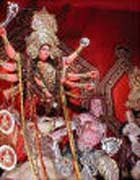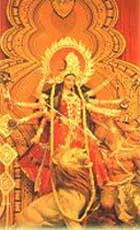Goddess Durga is believed to exist in many forms like Goddess Bhavani,
Jagdamba, Mahakali etc. Devotees perform the 'devi-sthaapna' in their
homes wherein they invite the Goddess and perform 'puja-path' for nine
days.
In West Bengal, Navratri is celebrated as 'Durga-puja' which is the most
important festival in that part of India. Celebrations of Durga-puja in
Bengal are similar to celebration of Ganesh Chaturthi in Maharashtra.
Idols of Goddess Durga are worshipped for nine days in beautifully
decorated 'pandaals'. It is a public festival. On the tenth day,the
'Visarjan' or immersion of idols is performed. Community pujas in
Bengal are organised in every locality. Family visit each other to
share feasts. On Bijoya day, the idols are taken in elaborate
processions for immersion in the river or sea.
In North-India the 'Ram-Leela' is performed during Navratri. Ram-Leela
is a stage enaction of Ramayana, the story of Lord Rama. The day after
Navratri - the tenth day, is observed as 'Dassera' or 'Vijayadashmi'. It
marks the victory of good over evil. It is believed that on this day,
Lord Rama had killed the demon Ravana. On Vijayadashmi, effigies of
Ravana are burnt all over India.
Festivals and Fairs |
   |

